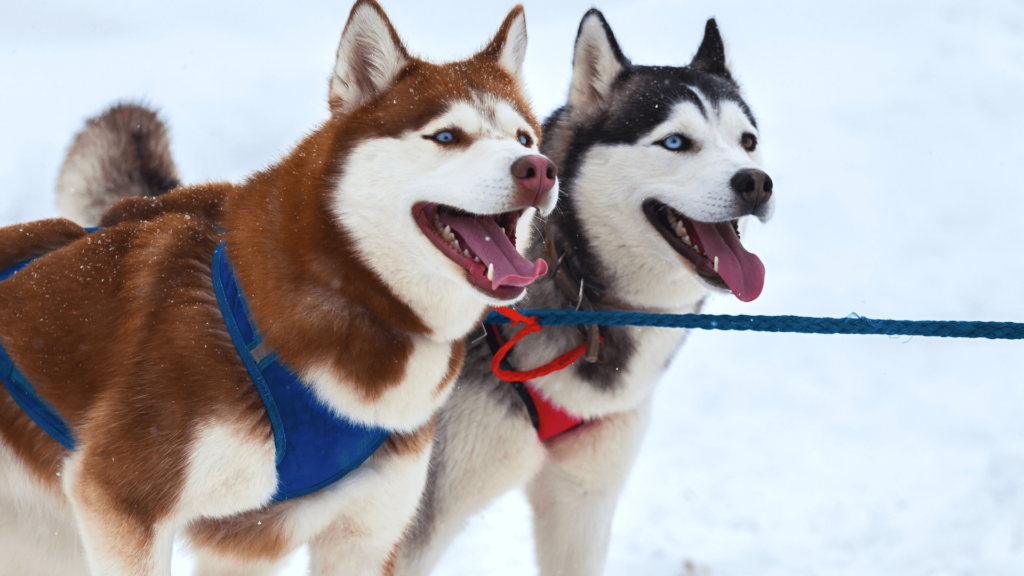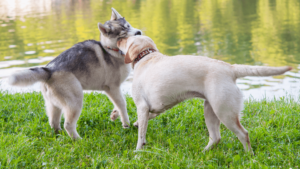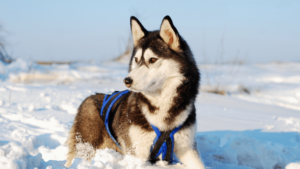Husky Dog Breeds: Discover the Majestic and Loyal Husky Dog Varieties

History of Husky Dogs
The legacy of Husky dogs spans centuries, reaching as far back as 4,000 years in the Arctic land of Northern Siberia. Here, these majestic creatures were integral to the Chukchi tribe
, serving as multi-functional dogs, aiding in transportation, hunting, and even providing warmth in the frigid winter months. Their tenacity, intelligence, and adjustability earned them a strong reputation for dependability and trust.
Huskies' capability to maneuver through snow-covered landscapes and withstand rough weather conditions made them invaluable to the people of Siberia. Throughout history, Huskies have been a vital part of human life, not only as working animals but also as cherished family members. Their story is a tribute to their indestructible bond with us.
Huskies have had a long-standing relationship with human civilization, particularly as sled dogs. Their muscular build and unwavering strength made them the perfect choice for towing heavy loads across long distances. Though Siberian Huskies are the most recognizable breed, other Northern breeds, such as Alaskan Malamutes and Samoyeds, are also colloquially referred to as Huskies.
Each breed shares a common origin, rooted in their ability to survive in cold climates and their loyal devotion to their human counterparts. This history of Huskies is a testament to their lasting popularity and their incredible journey beside mankind.
Types of Husky Breeds
Exploring majestic, loyal Husky dogs requires an understanding of their varied breeds. The Siberian Husky boasts an ancient lineage, tracing back thousands of years to the Chukchi tribe of Northern Siberia.
Boasting a thick, double coat in countless colors, they have been employed for a variety of purposes. Another popular Husky is the Alaskan Malamute, one of eight Husky breeds. Though they share common traits with the Siberian Husky, they are distinct in their own right.
Further Husky types include the Alaskan Husky, Labrador Husky, American Eskimo Dog, American Klee Kai, Sakhalin Husky, Azurian Husky, and Greenland Dog. Each of these breeds possesses a unique set of characteristics, contributing to the diversity of Husky dogs.

While the Siberian Husky is the only breed acknowledged by the American Kennel Club, Husky is often used to refer to other breeds from Siberia. Examining the various types of Husky breeds reveals the profound history and remarkable qualities of these dogs.
Siberian Husky Characteristics
The captivating beauty of the Siberian Husky is undeniable. These dogs are known for their mesmerizing eyes, which range from blues to multicolors, as well as their dense double coat, which can come in a variety of colors, including black, gray, red, and white.
Along with their erect ears and bushy tails, they truly have an air of regality.
Not only are Siberian Huskies stunning to look at, but they also have a range of remarkable qualities. They are intelligent and independent, making them great companions for an adventurous lifestyle. Plus, they are typically very affectionate and tolerant of other dogs and children. However, due to their strong predatory drive, it may not be suitable for households with smaller pets, such as cats and bunnies.
Siberian Huskies have a dynamic and vivacious nature. They are born to run and require consistent exercise to remain content and healthy. These dogs are renowned for their endurance and have a history of being used for sled pulling and long-distance racing.
Therefore, providing daily activities such as walks, runs, or engaging in canine sports like agility or obedience training is essential for their well-being. Without enough physical activity, these dogs can become restless and indulge in destructive behavior.
Another noteworthy characteristic of Siberian Huskies is their prodigious shedding. Their thick double coat keeps them warm in the coldest of climates, yet it also means they lose a lot of hair, especially during season changes. Regular brushing is necessary to manage the shedding and prevent matting.
Despite this, many Husky admirers find the breed's beauty and remarkable personality traits an ample reward for the extra grooming.
Learn about Siberian Husky
The Siberian Husky is a captivating canine with a long history and specific qualities. To learn more about these majestic and devoted members of the husky family, look no further.
Here, we will delve into the world of Siberian Huskies, investigating their roots, personality, and physical characteristics. Let's explore what makes the Siberian Husky so beloved and distinctive.

The Siberian Husky has a storied past, having originated roughly 4,000 years ago in Northern Siberia. Bred by the Chukchi tribe as all-around companions, these dogs have maintained their incredible vigor, agility, and resilience. Whether racing over snowy terrains or simply providing an affectionate presence, the Siberian Husky is an exemplary example of the husky breed.
The Siberian Husky has several physical attributes that set it apart. These dogs have a medium-sized, well-proportioned body, standing between 20 to 23.5 inches tall and weighing 35 to 60 pounds. Plus, their thick double coat provides insulation and protection from harsh conditions, making them ideal for colder climates. Furthermore, Siberian Huskies come in a range of colors, from striking black-and-white combinations to awe-inspiring red and grey hues.
In addition to their alluring appearance, it is the Siberian Husky's personality that truly captivates. These pooches are renowned for their friendly and gentle nature, making them excellent companions for families, other pups, and even felines.
However, it is important to remember that the Siberian Husky has a high activity level and needs regular exercise to stay content and healthy. They may also present a few training hurdles due to their intelligence and independent nature, but with patience and consistency, they can be obedient members of the family.
To learn more about the captivating Siberian Husky, read on to discover further information about its history, grooming needs, and much more.
Other Popular Husky Breeds
Popular breeds of Huskies, often mentioned in the same breath as the Siberian Husky, include the Alaskan Malamute, Labrador Husky, and American Eskimo Dog. All of these dogs share a common bond of loyalty and devotion, yet they have their unique traits and characteristics.
The Malamute is known for its large size and strength, the Labrador for its agility and stamina, and the American Eskimo Dog for its playful and friendly nature.
The American Klee Kai is another Husky that deserves a mention. Bearing a striking resemblance to the Siberian Husky with its blue eyes and thick coat, this breed is smaller in size but no less energetic. Intelligent and full of adventure, the American Klee Kai is an excellent choice for active individuals or families.
Two rare Husky breeds are the Sakhalin and Azurian Huskies. Originating in Japan and Kazakhstan respectively, these breeds are renowned for their endurance and unique appearance. The Sakhalin Husky was traditionally used for sled pulling and transportation in the cold northern regions, and the Azurian has striking blue eyes and a distinctive coat. Both of these breeds exhibit all the charm and appeal of their more well-known cousin, the Siberian Husky.
Personality and Care Requirements of Husky Breeds
Huskies are enticed with their distinctive and alluring personalities. These pups possess considerable wisdom and self-reliance while also exuding high levels of energy. It is essential to offer them plenty of physical and intellectual stimulation to keep them content and balanced. Without proper outlets for their vigor, Huskies can become dull and display destructive behavior.
Therefore, it is imperative to adopt an active lifestyle and allocate time to interacting with your dog through activities like trekking, running, or taking part in canine sports.
Furthermore, Huskies are highly sociable animals and profit from companionship. They take pleasure in being part of a pack and will cherish spending time with their human family and other canines. Investing effort in training and socializing your dog from a young age will guarantee they develops into obedient and adjusted pooches.
When it comes to grooming, Huskies boast a plush double coat that necessitates regular maintenance. They cast their undercoat twice a year, which means you must be ready for a significant amount of fur around your abode during these periods.
Brushing daily during molting seasons can aid in reducing the quantity of loose hair and keep their fur healthy. Outside of shedding seasons, their coat is fairly low-maintenance and only requires occasional brushing to keep it spotless and free from mats. It is important to note that Huskies are generally clean canines and do not have a pronounced odor, making them a perfect selection for individuals with allergies or sensitivities.
Additionally, routine dental care, such as brushing their teeth and providing dental chews, is essential for preserving their oral hygiene.
As with any pooch, training is an indispensable aspect of caring for Husky breeds. Due to their intelligence and autonomous nature, Huskies can be somewhat stubborn and necessitate consistent and tolerant training methods.
Positive reinforcement techniques, such as rewards-based training and utilizing treats or praise, are most effective with these sagacious canines. It is essential to establish yourself as the pack leader and set transparent boundaries and regulations for your dog.
Early socialization is also essential to guarantee they mature into well-mannered and affable creatures with other animals and people. Providing intellectual stimulation through puzzle toys, obedience training, and interactive games will facilitate keeping your dog's mind acute and forestalling boredom.

Leave a Reply